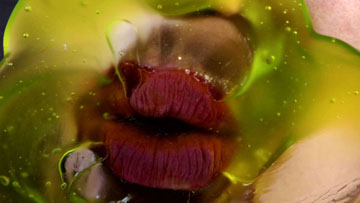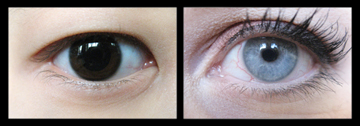
Marilyn Minter, "Green Pink Caviar," 2009.
When I heard that Marilyn Minter’s video, Green Pink Caviar, would be showing on the Mezzanine of The Standard Hotel, I imagined something exquisite: maybe the projection would appear on a balcony that curved around the hotel’s lounge, visible to those below and above it. Mezzanine is, after all, the French rendition of something Italian, a word that slides romantically off the tongue and conjures images of wrap-around railings. I was sure seeing Minter on the Mezzanine would be a singular experience. And it was, just not the kind I expected.
Apparently, when The Standard says “Mezzanine,” it more or less means “hallway.” Projected on a back wall, a few yards away from two gold-doored elevators hotel guests seem to use sparingly, Minter’s video played at a slight angle and the hotel’s mood music drowned its soft soundtrack. Usually, Minter’s work makes glamor visceral and slightly repulsive, but in a subliminal way. In this dark hallway, glamor became visceral in the grainy, horror movie sense. The long-tongued model in the video–who, filmed from below a glass surface, licks up colorful syrups–looked like an over-sexed alien, the type David Lynch might think up.
But what bothered me most was that I was supposed to be experiencing a public art project. While I stood there watching, no public joined me and the few people who passed—mainly men in their early 30s, one of them wearing the an L.A. Lakers shirt with silver embossing—didn’t even seemed to notice the video.
Los Angeles, like many other cities, has welcomed an influx of public video and billboard art over the last few years. Many of us within the art community have celebrated this influx as noble, as if art is fighting back against the commercial videos and digital billboards that saturate urban neighborhoods. Lately, however, I’ve found myself questioning that nobility.

Doug Aitken, "Migration," 2008. Courtesy Regen Projects.
In September, Regen Projects projected Doug Aitken’s film, Migration, on the exterior of its West Hollywood building. I drove by a few times before parking and actually getting out to look. Aitken’s film has to do with duration and waiting; it consists of slow-moving shots of weirdly self-possessed animals who linger in hotel rooms. Its carefully crafted lethargy is hard to appreciate without watching in full. But standing at the corner of Santa Monica and Almont, I felt out of place. Passers-by seemed to be paying more attention to my unexpected presence than to the video and, during the ten minutes I was there, no one else stopped to watch.
A few days earlier, I had viewed Aitken’s film alone in an empty gallery. That sort of privacy seemed natural. I was in a space that existed for people who submit to video art for its duration because, if they’re like me, they doggedly believe that the watching experience itself is what’s valuable.
Both Minter and Aitken make work that asks for time. If you don’t stop and watch, you’ll miss the bizarre numbing effect of the tongue that goes down again and again for more or the absurd sense of alienation that comes from seeing animals un-ironically mimic human habits. So what is their work doing in thoroughfares and hallways?

Su-Chen Hung, "Seeing Time." 2007. Appeared in Hollywould: Freewaves 11th Festival of Experimental Media Arts. Courtesy Freewaves.
Speaking at the L.A. Convention Center during the 2009 CAA Conference, artist Anne Bray described hesitating when asked to curate work on a digital billboard off a SoCal freeway. She disliked digital billboards in general and the way they impose themselves on the public in particular; they prey on people’s natural tendency to look at anything that moves. She also found that most artists who want their work on billboards don’t make billboard-appropriate work. If art is going to resonate with a moving audience, it has to communicate quickly. But much video art isn’t about being quick. It’s about time and the process of experience. So how can video go public? Bray has grappled with this problem for years. She has staged events, inviting people to come and see videos projected in public spaces for one night only. She has also co-run festivals that last whole weekends, like last year’s Hollywould Freewaves Festival, at which video art invaded venues all around Hollywood Boulevard, making art and life cohabitate for a set period of time.
Now that video art and digital projectors are no longer novelties, it’s time for more artists to take a strategic approach to public installations, finding locations that actually compel passers-by to watch or making videos that, like ads, can be digested in an instant. Then maybe I’ll find myself viewing public art in private less and less often.



